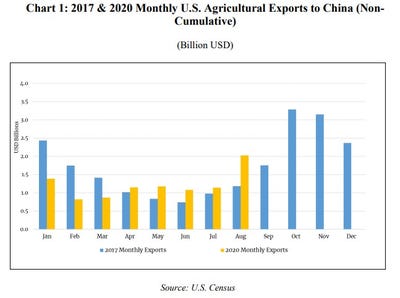Ag sales to China on pace to break records
All-time high purchases projected for U.S. beef, pork, corn and soybeans, and many technical commitments opening up additional trade.

The Office of the U.S. Trade Representative (USTR) and the U.S. Department of Agriculture issued a report highlighting the progress made to date in implementing the agricultural provisions in the U.S.-China Phase One Economic & Trade Agreement, which they said is “delivering historic results for American agriculture.”
China has substantially ramped up its purchases of U.S. agricultural products. The report noted that China has purchased more tha $23 billion in agricultural products to date, approximately 71% of its target under the Phase One agreement.
This includes the following highlights:
Outstanding sales of U.S. corn to China are at an all-time high of 8.7 million tons.
U.S. soybeans sales for the 2021 marketing year are off to the strongest start in history, with outstanding sales to China double 2017 levels.
U.S. exports of sorghum to China from January to August 2020 totaled $617 million, up from $561 million for the same period in 2017.
U.S. pork exports to China hit an all-time record in just the first five months of 2020.
U.S. beef and beef product exports to China through August 2020 already were more than triple the total for 2017.
“It is still to be seen whether they meet their target but particularly given the COVID-19 effects on the global economy they are making substantial progress,” the report stated. “It is worth noting that the Phase One agreement did not go into effect until Feb. 14, 2020, and March is the first full month of its effect. That means that we have seen seven months of agreement sales.”
Looking at simple import or export numbers alone is misleading because actual sales oftentimes lag exports by several months. The report combines actual export numbers with the sales indicated in the USDA weekly export sales reports.

In addition to these products, USDA expects 2020 sales to China to hit record or near-record levels for numerous other U.S. agricultural products, including pet food, alfalfa hay, pecans, peanuts and prepared foods.
Since the agreement entered into force, the U.S. and China have addressed a multitude of structural barriers in China that had been impeding exports of U.S. food and agricultural products. To date, China has implemented at least 50 of the 57 technical commitments under the Phase One agreement. “These structural changes will benefit American farmers for decades to come,” the report stated.
The changes affect the entire range of agricultural products, including corn, soybeans, dairy products, poultry, pork, beef, horticultural products, pet food and animal feed. Before the Phase One agreement, only approximately 1,500 facilities in the U.S. could export agricultural goods to China. Today, that number has increased to more than 4,000 facilities.
U.S. poultry farmers have capitalized on the new opportunities opened up for them after a four-year-old ban related to avian influenza. In the first eight months of this year, poultry farmers exported nearly $436 million in poultry meat to China. “At the current pace, we expect a record year for poultry meat exports to China,” the report stated.
Dairy regulatory updates have also brought expanded opportunities for exports to China. As a result, exports of U.S. dairy products to China from January through August 2020 were already up 38% compared to the same period in 2019 and are expected to continue to rise.
U.S. Agriculture Secretary Sonny Perdue said, “This China Phase One agreement is proof President [Donald] Trump’s negotiating strategy is working. While it took China a long time to realize President Trump was serious, this deal is a huge success for the entire economy. This agreement finally levels the playing field for U.S. agriculture and is a bonanza for America’s farmers, ranchers and producers. Being able to participate in this market in a more fair and equitable way has generated more sales that are supporting higher prices and strengthening the rural economy.”
U.S. Trade Representative Robert Lighthizer added, “President Trump delivered on his promise to confront China’s unfair trade practices and expand market opportunities for U.S. agriculture through the Phase One agreement. Since the agreement entered into force eight months ago, we have seen remarkable improvements in our agricultural trade relationship with China, which will benefit our farmers and ranchers for years to come."
USTR and USDA continue to work closely with the Chinese government to ensure that the Phase One agreement is fully and properly implemented so that access for U.S. food and agricultural products into the Chinese market can continue to expand moving forward.
About the Author(s)
You May Also Like





